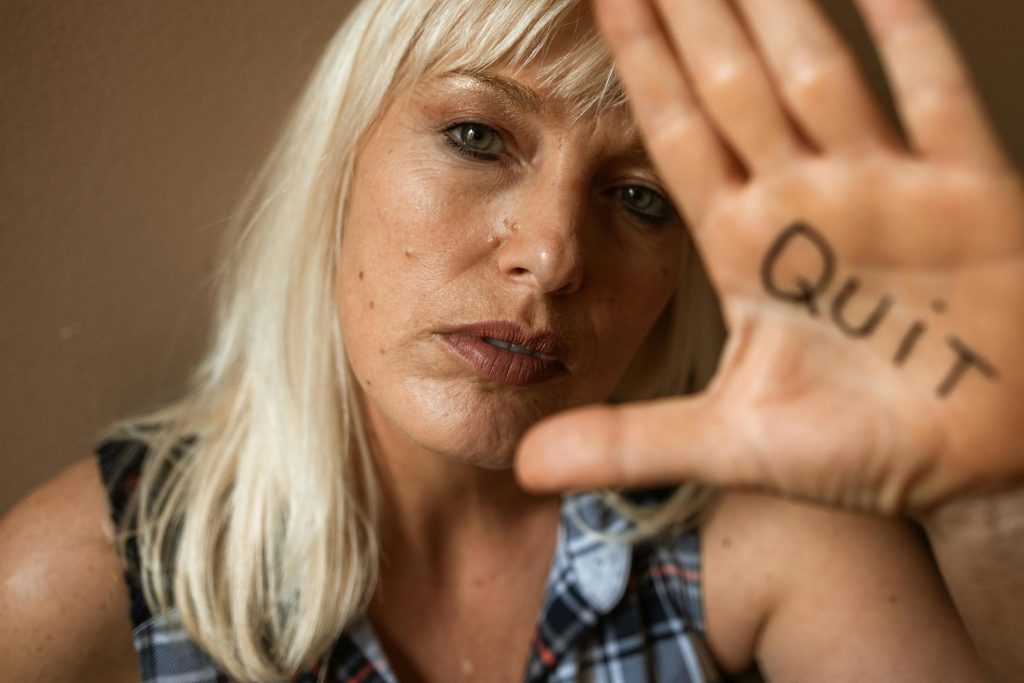How to Give Up the Things That Are Bad for You
Photo by Thirdman
Humans have a habit of…um collecting bad habits that we know will harm us more than they help us in the long term but which we simply cannot give up for whatever reason. But you know what? It really doesn’t have to be that way! I’m not saying it will be easy to give up the things that are bad for you, but it is possible, Here’s how:
1. Identifying Your Vices
First things first, let’s play detective with our own lives. Identifying your vices is a bit like figuring out who ate the last slice of pizza—it’s personal, and you really need to get to the bottom of it. Start by taking a good, hard look at your daily routines. What habits are you not so proud of? What activities make you feel lousy afterwards? And what can’t you seem to stop, even though you know it’s not doing you any favors?
Writing these down can be eye-opening (and a little horrifying), but it’s the essential first step. It’s easy to overlook how much these little things impact your life when you’re in the thick of them. Think of it as stepping back from a painting to see the whole art piece, not just the weird-looking splotch in the corner.
2. Understanding the Whys
If you want to give up those pesky habits that are doing you no good whatsoever, then you absolutely do need to work out why you have formed those habits in the first place. Knowing why you cling to certain vices is a vital part of the process of breaking them. Are you stress-eating ice cream because you’re stressed, or is it just because it tastes like a spoonful of heaven? Digging into these questions can reveal emotional triggers or voids you’re trying to fill.
For example, you might have started drinking a glass of wine each night to help you relax after a stressful work day, but now relaxing feels impossible without it. Or maybe you spend hours gaming each weekend to escape your loneliness. Recognizing these patterns doesn’t mean you’re flawed; it means you’re human and you’ve been coping in the ways you knew how.
3. Setting Realistic Goals
Hold your horses before you vow never to touch a carb again or start training for a marathon out of the blue. Setting realistic, achievable goals is key to long-term success. If your goals are too grandiose, you’re setting the stage for a spectacular crash and burn (and not the cool kind in action movies).
Break it down into manageable steps. Want to cut down on junk food? Start by introducing healthier snacks into your diet rather than eliminating all snacks. Looking to reduce screen time? Try turning off devices an hour before bed rather than attempting a full digital detox overnight. It’s about incremental progress, not instant perfection.
And remember, every journey starts with a single step—or, in the case of giving up bad habits, with throwing away that last pack of cigarettes or deleting that fast food delivery app. Small actions can lead to big changes, setting the foundation for healthier habits that stick.
4. Finding Alternatives
Removing the things that are bad for you from your life is definitely a whole lot easier if you have a positive alternative to throw yourself into instead. After all, if it still hits the spot, you won’t miss the old habit so much, right?
For instance, if you’re trying to reduce caffeine, drink a delicious herbal tea instead. You’ll still be hydrated and have the hot mouth feeling, but without the caffeine. The same can be said for smoking cigarettes, some people will use a vape to help them wean off the nicotine addiction, especially if they got addicted through cigarettes.
Similarly, if social media mindless scrolling is eating up your productivity, try replacing this habit with timed reading sessions or another hobby that can relax or stimulate you without a screen.
Finding an alternative isn’t just about swapping out bad for good; it’s about making the good feel equally satisfying. If your vice is indulging in sweets when stressed, find a treat that feels indulgent but aligns more closely with your health goals, like dark chocolate or a fruit smoothie. The key is ensuring these alternatives provide comfort or distraction that’s similar to the habit you’re trying to break.
Photo by RDNE Stock project
5. Leaning on Support Systems
Nobody is an island, especially when it comes to making life changes, which is why building a strong support system is one of the best things you can do when you are trying to leave bad habits behind you once and for all. Whether it’s friends, family, or a community group, having people who understand and support your journey can make all the difference to how successful you ultimately are. They can offer encouragement, keep you accountable, and be there to pick you up if you stumble along the way.
For those times when friends and family might not fully understand what you’re going through, consider joining a recovery program or support group. Programs like Alcoholics Anonymous or online forums for quitting smoking can connect you with others who truly understand the struggle and can share insights and encouragement from their own experiences. It’s about finding your tribe—people who don’t just sympathize but empathize with your journey.
6. Embracing Professional Help
As someone whose father was a drug addict my entire life, I know sometimes, willpower and social support aren’t quite enough, and that’s okay. Seeking professional help from a therapist or counselor of BetterHelp who can offer effective cocaine treatment strategies or smoking cessation help, for example, can provide you with tailored strategies to overcome your specific challenges. These professionals can help you understand the root causes of your habits, develop personalized coping strategies, and provide a safe space to explore your emotions and setbacks without judgment.
Think of a therapist as a personal trainer for your mental health. Just as you’d hire a trainer to help you achieve your fitness goals, a therapist can guide you through your emotional and psychological goals. They’re there to push you, support you, and help you grow stronger in areas where you’ve previously struggled.
7. Celebrating Milestones
Every step away from a bad habit and towards a healthier lifestyle deserves recognition. These victories should be celebrated whether it’s one week without a cigarette, a month without junk food, or even a day of managing stress without turning to your old crutches. Rewarding yourself reinforces positive behavior and keeps you motivated for the long haul.
Choose rewards that don’t contradict your new goals. For instance, if you’re cutting down on sugar, don’t celebrate with a cake. Instead, treat yourself to a new book, a day out in nature, or a new outfit. These kinds of rewards acknowledge your hard work and enrich your life in other fulfilling ways, reinforcing the benefits of your new lifestyle.
8. Preparing for Setbacks
Of course, when you are trying to leave the things that are bad for you behind, it is fair to say that it is not all sunshine and rainbows, and even the most determined of us will experience setbacks along the way. The key to not letting those setbacks ruin your progress is to plan for them so that you do not fear them. Understand that slip-ups don’t mean failure; they’re just part of the journey. When you accept that setbacks can happen, you remove much of their power and stigma, which makes them easier to overcome.
Create a plan for dealing with setbacks. This might include reaching out to a friend or mentor, revisiting your reasons for changing or practicing specific coping strategies that you’ve developed with a therapist. Keep a journal of what triggers and how you successfully overcome your setbacks, as this can become a valuable tool for future challenges.
Moreover, try to view setbacks as learning opportunities. Each time you slip up, you learn a little more about what works and what doesn’t, which fine-tunes your approach to ditching bad habits. It’s a bit like tweaking a recipe; sometimes you need to adjust the ingredients a few times before you get it just right.
9. Harnessing Technology for Support
In today’s digital age, technology can be a powerful ally in your journey to ditch bad habits. Leverage apps and online resources that are designed to support habit change. From apps that track your progress in quitting smoking or reducing alcohol intake to platforms that help you monitor your diet and exercise, technology can provide both the tools and the motivation to stay on track.
For instance, consider using a habit-tracking app that allows you to set daily reminders and goals, track your progress visually, and even share your successes on social media for added accountability. There are also online communities and forums where people discuss their challenges and successes, which can give you a sense of community and belonging, knowing you are not alone in your struggles.
Incorporating these tech tools into your strategy can make the process more interactive and fun. It can turn the daunting task of changing habits into a gamified experience with rewards and achievements along the way. This can significantly boost your motivation and commitment to your goals, making the journey more engaging and less burdensome.
10. The Continuous Journey
Remember, giving up bad habits is a continuous journey, not a one-time event. The landscape will change as you grow, and your strategies might need to adapt over time. Stay flexible, keep learning about yourself, and adjust your methods as your life and needs evolve.
Most importantly, keep looking forward, and don’t beat yourself up over the past. Celebrate the person you’re becoming through all this hard work. You’re not just removing negative elements from your life but building a stronger, happier you.
Giving up things that are bad for you takes courage, commitment, and a lot of self-love, but it is possible if you are ready to do so and have as much support as you can find. Good luck!







